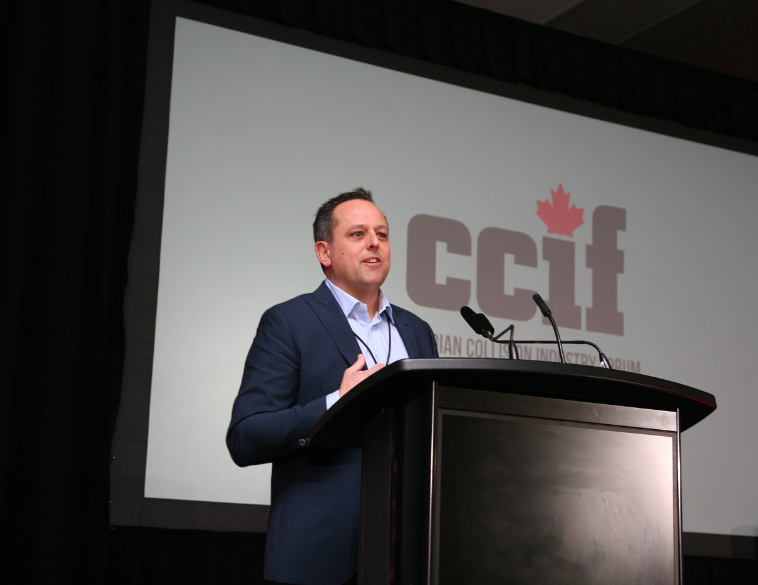The event focused on margin compressions, the practicality of EV adoption, plus key issues such as female recruitment and towing and storage management.
On February 2-3, collision industry professionals gathered for the first Canadian Collision Industry Forum event of 2023, CCIF Toronto. Hosted at the Delta by Marriott Toronto Airport hotel and conference centre on Dixon Road, near Lester B. Pearson International Airport, CCIF Toronto was a sold-out event, attracting 480 registered attendees.
On February 2, two workshops were conducted, and Autosphere attended the session hosted by John Cox, Business Services Manager (Canada) for AkzoNobel. Entitled Creating a Culture of Execution, the session focused on ways that collision repairers can take sound ideas and actually execute them. Cox referenced the Four Disciplines of Execution, a book by Chris McChesney, Sean Covey and Jim Huling, and how these principles can be successfully applied to the collision repair space.
Strategy and tactics
Cox explained that while it is easy to generate ideas, it is often much harder to implement them. He said it was important to understand that the ability to successfully execute comes down to applying both strategy and tactics and creating a system that enables the business and the people within it to win. Doing so requires absolute commitment and real clarity in achieving your objectives. The four disciplines are:
- Focus on the Wildly Important
- Act on Lead, not Lag Measures
- Keep a Compelling Scoreboard
- Create a Cadence of Accountability
By implementing these four disciplines, Cox explained that the results can be transformative in a collision repair organization and lead to a continuous and ongoing improvement process, much like the Japanese “Kaizen” approach to business, popularized by organizations such as Toyota Motor Corporation.
Following the workshop, attendees had the opportunity to network at an evening cocktail reception, which proved exceedingly popular, drawing a large crowd of both new and familiar faces in the industry.
Encouraging the next generation
On February 3, the agenda kicked off with a welcome introduction from CCIF Chairman Jeff Labanovich. He discussed three key factors or pillars impacting the industry—Profitability/Sustainability, People and Vehicle Complexity. Regarding the people piece, he said a key goal is to attract more collision repairers and OEMs to events like CCIF. In fact, a stated goal of the forum is to have around 50% of attendees from collision centres.
Labanovich stressed the importance of encouraging the next generation of repairers about the amazing opportunities available in the industry and how finally, the conversation at the family dinner table is changing as skilled trades are being seen as viable careers for young people today. That being said, Labanovich noted it was important for the collision repair industry and all stakeholders within it to actively promote and engage with the public, through social media, through partnerships and initiatives with education and learning institutes; as well as utilizing platforms like CCIF as a catalyst for creating lasting and beneficial change—not only for the industry but also those within it. Referring to the solutions-based approach of the CCIF Steering Committee, Labanovich said “we need to set our solutions and we need to deliver on them.”
More expensive vehicles, fewer choices
In his Global Light Vehicle Sales Outlook presentation, with a focus on the Canadian market, Guido Vildozo, Senior Manager, Americas, Light Vehicle Sales Forecasting for S&P Global, explained that there are some interesting trends developing when it comes to vehicle sales.
A key one is that they will become much more expensive—25 percent more expensive by 2025-26 due to a number of factors. Key ones include ongoing supply chain and semiconductor chip shortages, plus geo-political factors such as the ongoing conflict in Ukraine and government attempts to mandate sales targets of EVs.
Additionally, aggressive interest rate hikes also mean that consumers are choosing to hold onto their existing vehicles longer. Furthermore, this current push toward EVs means that price points are expected to increase, meaning OEMs will no longer find it feasible to offer vehicles in certain price segments, such as subcompact cars.
Furthermore, the Government of Canada’s plan to have 100 percent of all vehicle sales electric by 2035 and decoupling from U.S. EPA emissions and fuel economy standards could potentially have big ramifications for the collision industry, since under this scenario you could well have fewer vehicles chasing fewer buyers, meaning fewer opportunities for profitable repairs.
Reducing waste
Profitability and margin compression are key issues impacting collision repair at present and, during his session entitled Optimizing the Parts Supply Chain, Paul Gange, President, North America for Advantage Parts Solutions noted that so-called “waste” is a big problem in the collision repair industry. “This is threatening stability in our industry,” Gange explained. He said that often, not enough consideration goes into the true costs for the repair, including administrative costs, the time it takes to process the claim and the number of people involved.
Gange noted that one way the industry can control this leakage is by greater transparency when it comes to exchanging data between stakeholders and, collaboration that focuses on transparency and honesty. He posed four questions to the audience:
- Are you experiencing pressure on profitability?
- Do others understand your needs?
- Are you in control of your future?
- Do you wish change could happen faster?
Gange explained that nearly everyone in the collision repair industry is dealing with these issues and a key reason why is that relationships are fragile, if not fractured in many cases between stakeholders. He talked about re-writing the scales, leveraging the power of technology, data; training and segmentation in the industry in order to ensure that repairers are fixing the right vehicles in the right places.
By doing so, repairers and other key stakeholders can better harmonize their objectives, improving not only the repair process but also cash flow and profitability. Gange also stressed the importance to look at new ideas and concepts, since in collision repair and other industries, change is the only constant.
Better training, better rates
Lane Bailey, Vice President of ELC Solutions, discussed Navigating the Pitfalls of Towing and Storage. For far too long, towing and storage have been contentious issues for the collision repair industry. A key problem is that managing the towing process from the scene of the collision is often very difficult to do.
Using the province of Ontario as an example, Bailey mentioned that legislation regarding the towing industry varies from one municipality to the other and in some jurisdictions, there are no regulations at all. This often makes it difficult and complicated to set towing rates, though Bailey noted that savvy operators should leverage their experience and knowledge to set rates at fair market value and do so amicably and constructively. The important consideration here is ensuring that staff and dispatchers are trained properly, otherwise towing logistics and costs can prove to be a major financial deficit when it comes to operating a collision repair business.
Documentation and transparency
Constrained by KPIs was the focus of a session by consultant/trainer Stefano Liessi who also hosted a workshop on the subject the previous day. Over the last 10-15 years, Key Performance Indicators have become an essential part of collision repair operations, but according to Liessi, KPIs can be a bit of a double-edged sword. While they help businesses identify and track metrics, it can be difficult to apply them to an industry where no two collisions and no two repairs are exactly the same.
Liessi said it was important for a collision centre to track everything and not just certain KPIs to achieve favourable outcomes on paper. Doing so, he explained, can be a disaster for the shop and other key stakeholders including the insurer, vendor, OEM and customer.
Ultimately, to make KPIs count and be effective, transparency between the shop, the insurer, vendors, the OEM and the customer is essential. Collision repair shops need to be profitable, but at the same time, they need to share with their key stakeholders what is required for each repair and how much it costs, from First Notice of Loss to the time the customer collects the vehicle. “There is nothing that states you cannot charge a fair price for services rendered,” stated Liessi, “but you have to do everything you say you’re going to do.” In other words, document and itemize every single thing and make sure you share it with your stakeholders.
Charging and infrastructure challenges
Electric Vehicles are a hot industry topic at the moment, but a lot of questions remain, particularly regarding infrastructure. Damon Aldrich, EV Development and Strategy Director Enterprise Holdings, took a look at some of the issues surrounding this in his session entitled: The Road to Electrification. While there is currently a lot of hype around EVs and political moves by governments to incentivize and legislate adoption, there are still, multiple things to consider.
Firstly, Aldrich said that as far as trends regarding adoption go, they are highly regionalized and secondly, the impact of semiconductor chip shortages has disproportionally impacted EVs, some of which are still in very short supply.
And secondly, while more OEMs are increasing R&D budgets related to EVs and bringing more products to market, this is causing a number of headwinds. A big one is infrastructure. Charging anxiety is a major issue since not everyone has access to a home charging unit and public units can be sporadic and unreliable.
For a company like Enterprise, which now offers EVs in select markets, charging plays a key role in determining how successful the user experience actually is. Charging duration and vehicle turnaround times are critical, as are customer needs and driving behaviours.
For a fleet operator like Enterprise, Aldrich stressed that when it comes to charging infrastructure, flexibility and choosing a location where the energy supply is readily available are essential components in making EV operations viable at the rental fleet level. And that applies whether customers are booking retail rentals or receiving an insurance replacement vehicle while their own is being repaired by a collision centre.
Opportunities for women
CCIF Toronto 2023 concluded with a presentation from Krystle Bollans, Director, Hertz Corporation, on the subject of Women in the Collision Industry. She shared some of her own experiences and how mentorship, getting involved to help improve the industry and paying it forward can reap huge benefits.
As a member of the board of the Women’s Industry Network (WIN), Bollans stressed how organizations like WIN can help in giving women the tools and support to truly succeed in the modern collision repair industry and she provided information on how to join WIN, as well as discuss upcoming initiatives being put forward by the non-profit organization.



